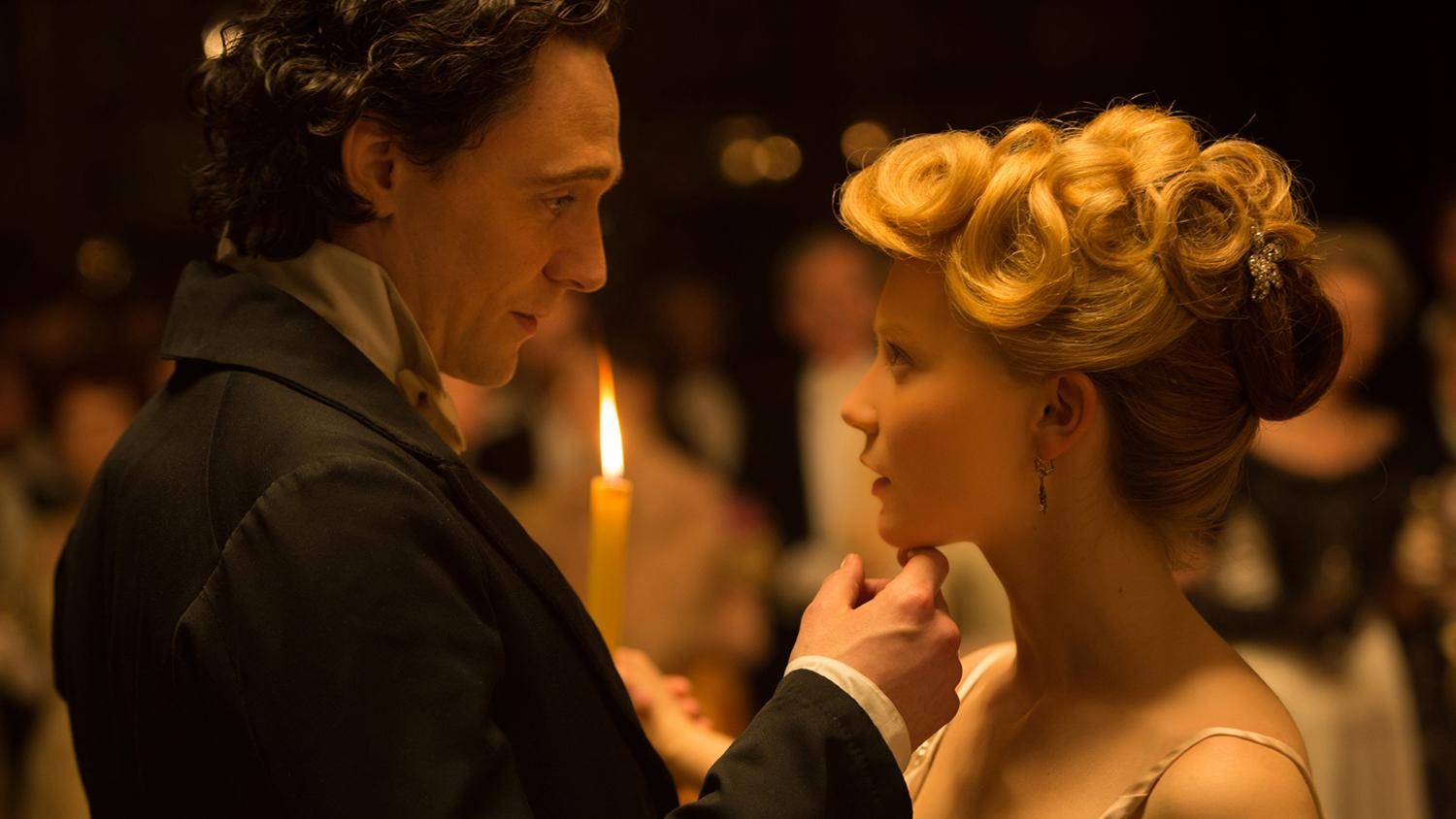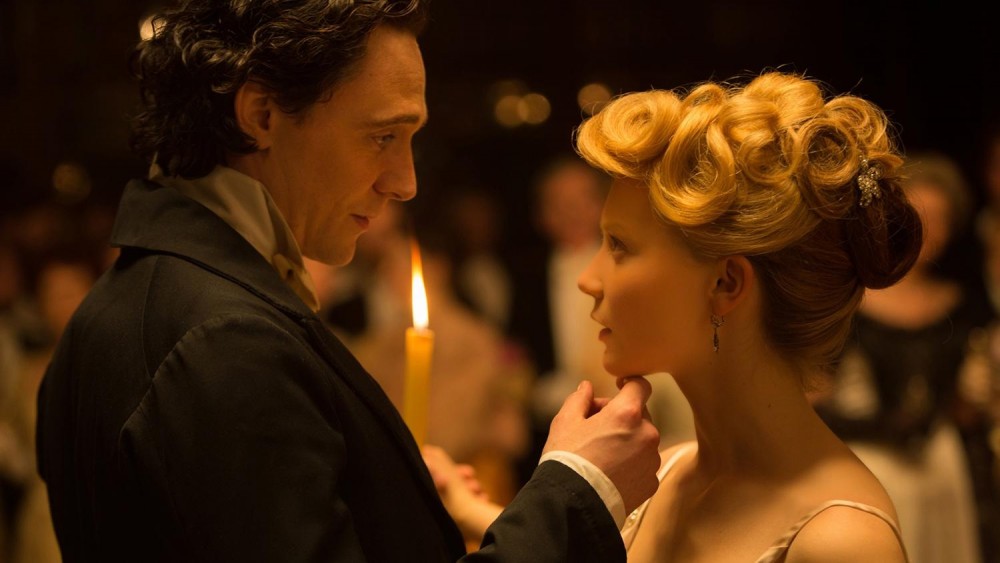“It’s not a ghost story. It’s a story with ghosts in it.”
Crimson Peak‘s protagonist and aspiring author, Edith (Mia Wasikowska), provides this meta commentary in the film’s first five minutes as shes describes her own manuscript. A mid-October release with trailers full of ghosts may have viewers thinking they’re walking into a a haunted house tale, but let’s get this out of the way: Crimson Peak is not a scary movie.
Classified by its director as gothic romance – an accurate description – Crimson Peak is the story of Edith Cushing. Cushing is a Jane Austen-esque heroine who takes little interest in men until she meets Thomas Sharpe (Tom Hiddleston), an Englishman trying to convince Edith’s father to invest in his decaying property and the red clay bubbling beneath it. Edith’s father quickly turns Sharpe down, but Sharpe is intrigued by Edith and begins a romantic pursuit, against the wishes of both Edith’s father and his own sister, Lucille (Jessica Chastain). Edith weds Sharpe and leaves her home in Buffalo to live with Sharpe and his resentful sister in England. As she begins to explore his crumbling clay empire, Edith sees visions of the dead roaming the halls and struggles to find her place in this new home.
As a gothic romance, Crimson Peak isn’t half-bad; the sexual chemistry between Wasikowska and Hiddleston is fantastic, and everything that took place before their arrival at the estate had me interested. Even in the estate, there’s a lot about the film that jives with what we’ve seen from del Toro in the past, including some of the most rich, luxurious, and vibrant visuals I’ve seen in any movie this year. The use of bubbling red clay leaking through the house gives it a wounded appearance; the house creaks, bleeds, and festers. Parts of this movie reminded me of the novel (not musical) Phantom of the Opera, a book I cherished when I was younger for its tragic and brutal romance. At its best, Crimson Peak is about falling in love with the wrong person and the pain that it yields. It’s cliche as hell, but in that way that del Toro is so adept with, bathing in its influences rather than winking at them.
…But then there are the ghosts. The ghosts, which aren’t really crucial to the story, and actually do it a good deal of harm by the end.
I understand that del Toro wants us to consider Crimson Peak a gothic romance rather than a ghost story, but he unfortunately dedicates the last half of the film to showing Edith exploring the house alone at night, jumping at each fleeting CGI vision she sees, begging them to tell her what they want so she can unravel the mysteries of this house and this family. It’s here that the film is at its most predictable, and honestly its most boring – I’m not sure why the ghosts were there at all.
And given that the film’s back half rests on the ghost story component of the script, it’s hard to call this movie a success. It’s frustrating, because I feel like Crimson Peak has the underlying potential to be the beautiful and horrifying tale of gothic romance that it esteems, if only it had dedicated the time spent chasing ghosts and metaphors to crafting more real, fractured characters. But the momentum it builds and all of the mastery in its design are squandered when the film steps away from the influences of authors like the Brontë sisters and suddenly veers in the direction of movies like Psycho without really dedicating itself to the fear and horror required to succeed.
The heart of the issue namely lies in the script, co-authored by del Toro, Matthew Robbins, and Lucinda Coxon (perhaps a case of too many cooks?). The direction is mostly well-done, ghost/haunting components aside, and the performances by Wasikowska, Hiddleston, and Chastain all live up to the promise they inspire. I appreciated having several strong female characters in the movie, and Chastain certainly did her part to elevate what could have otherwise been a fairly one-note role. Even Charlie Hunnam, who I usually can’t stand, finally has a role that suits him, playing a second-fiddle suitor rather than yet another bland, male lead.
But those pluses aside, it’s hard to whole-heartedly recommend Crimson Peak. It’s a movie I really wanted to like, and it’s got components that I love, but the whole affair is a mixed bag, filled with too many predictable, boring, and empty pieces.









Thanks for the even-handed review. This was one I was curious about. Couldn’t quite figure out the marketing of it.
Thanks! And yes, I think the marketing did this movie a disservice. People looking for a scary movie will likely be let down.
This absolutely bites. I was completely taken to believe that this was a haunted house movie and not a love story. I cannot tell you how disappointed I am about this info. It was advertised as a horror movie released during the Halloween season and now… well, crap.
SICARIO is the scariest (and most suspenseful) movie I’ve seen this year — because the brutal violence it depicts is really happening.
No doubt George, we thought the same thing. Although, I still think that film’s ending was a bit of misstep and took focus away from the character that it should have stuck with.
I was also surprised when SIRACIO’s focus shifted to another character (I won’t say which one, for those who haven’t seen the movie) but I accepted it. The movie is saying that good people get sidelined and marginalized, and they don’t always triumph. There’s no feel-good ending here.
I was also impressed that Emily Blunt’s character was NOT able to defeat bigger, stronger, well-trained men in hand-to-hand combat. We don’t see this sort of realism much in movies; the trend now is to depict all female protagonists as butt-kicking action heroes. Blunt’s character may be an FBI agent, but she’s not Buffy the Vampire Slayer, or Elektra or the Black Widow — that is, she’s not a superhero.
Comments are closed.